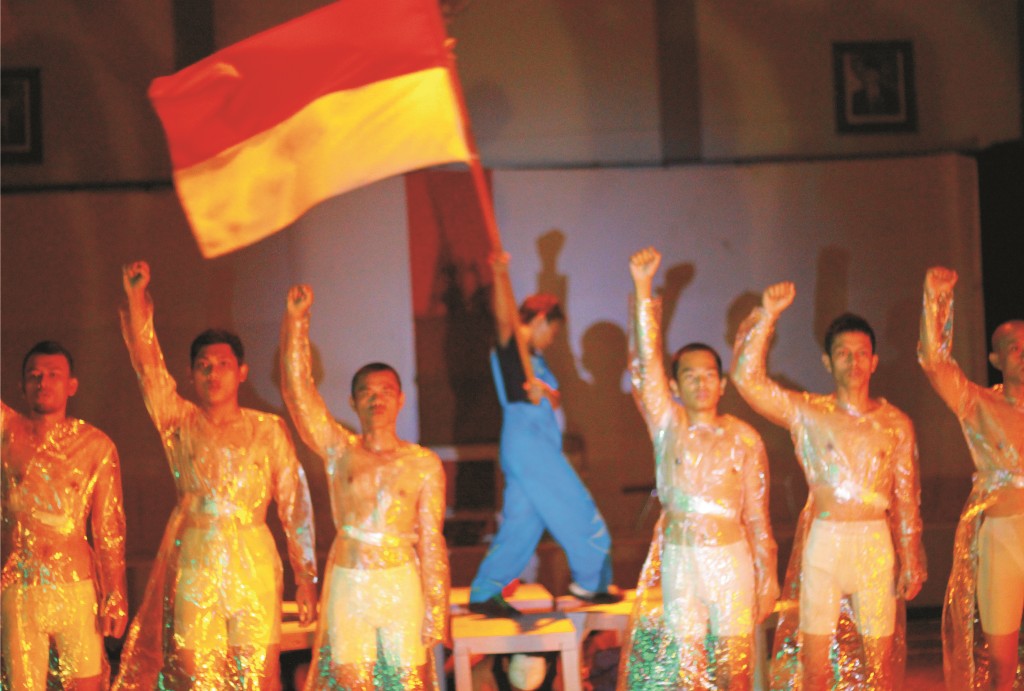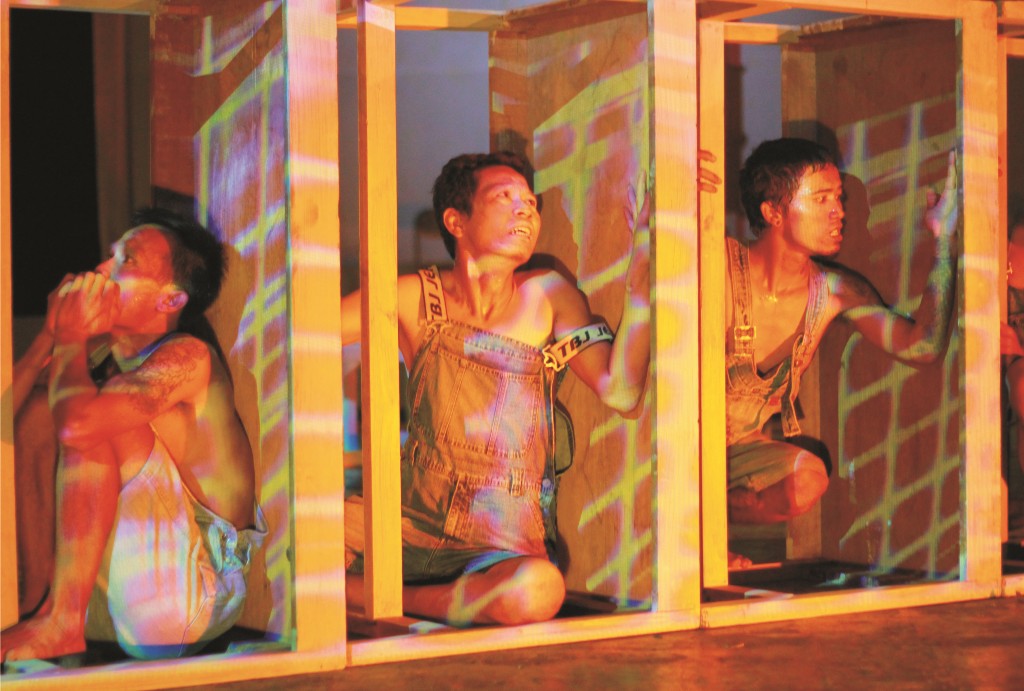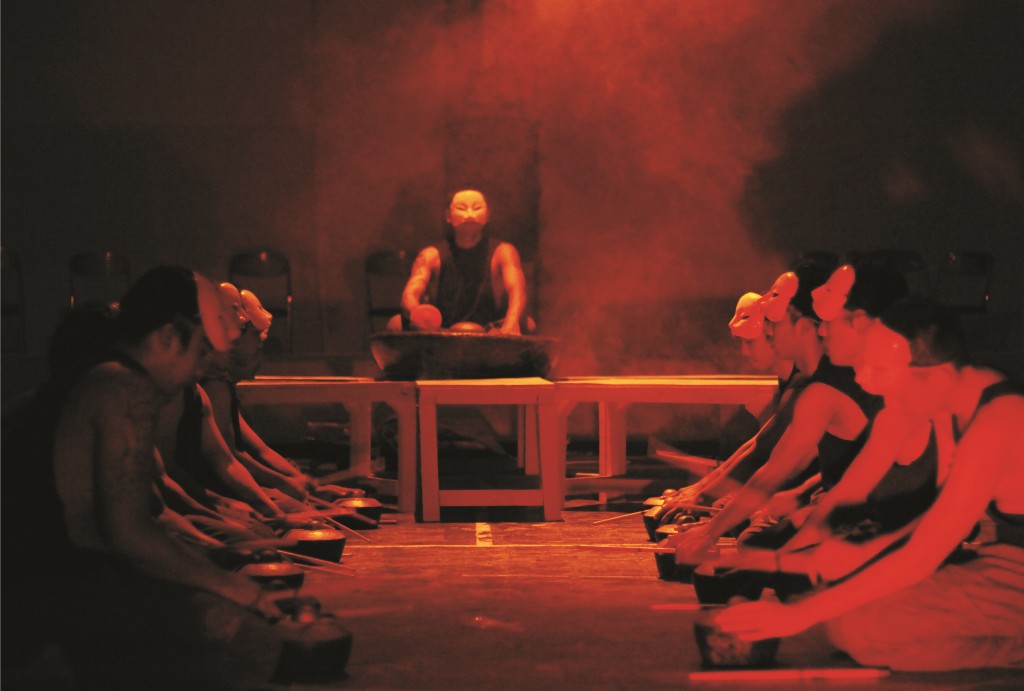Theatre therapy in a narcotics gaol is helping inmates survive
Josh Stenberg and Ad Akbar
 Prisoners singing the national anthem during their performance – Ad Akbar and M Firdaus
Prisoners singing the national anthem during their performance – Ad Akbar and M Firdaus
Six young men, clothed in work overalls, sit in the confined spaces between seven tables placed upright on their sides. As hard rock plays, the men hammer on the ‘cells’ created by the table legs. They scream, mope, crouch, collapse or space out, while disorienting projections of colours and speeding shapes play across their bodies. Then the music mellows, the projections stop, and the men climb up and crouch on the legs of the tables, hands upstretched.
We are in the dimmed assembly hall of Bandung’s Banceuy which, with 1500 inmates, is the larger of West Java’s two narcotics prisons. The occasion is the performance of ‘What’s Born from the Iron-Bar Womb’, a 75-minute piece of theatre created by prisoners and facilitated by Teater Cassanova, a drama group from Sekolah Tinggi Seni Indonesia Bandung (STSI). The show’s title refers to the creation of the piece itself – developed in gaol by inmates – but it also suggests the prisoners’ desire to one day recover their freedom and be reborn into the world.
A dramatic outlet
Theatre as a form of prison therapy has existed in the west for decades. The rationale which underpins it is that theatrical expression creates opportunities for personal expression that are otherwise unavailable in the impersonal and dehumanising environment of the prison. It also allows the release of strong emotions without the risk of retribution or discipline. Along with music and writing, theatre in prisons gives inmates the opportunity to work through remorse, trauma, anger and guilt in ways that are considered acceptable within the corrections system.
 Prisoners crouched between tables placed upright to represent cells – Ad Akbar and M. Firdaus
Prisoners crouched between tables placed upright to represent cells – Ad Akbar and M. Firdaus
But while theatre therapy is commonplace in many countries, in Banceuy the project was a fortuitous affair. There, it emerged organically without knowledge of its history elsewhere, and without assistance from mental health professionals or external funding.
The project started in 2012 at the suggestion of a new prison warden, Pak Acep, who was concerned that the monotony of prison life was damaging the inmates’ mental health. An arts enthusiast, Pak Acep was aware that one of the prisoners, Basir, had studied at STSI before his conviction for marijuana possession. Once in gaol, Basir had continued to pursue the arts as a way of keeping himself occupied, playing a key role in Banceuy’s victory at an inter-prison musical competition.
With this in mind, Pak Acep asked Basir to organise an event for World AIDS Day in December 2012. Fellow members of Teater Cassanova helped plan the event, which involved the arrangement of flags and sheets in various shapes, including the HIV/AIDS ribbon. The success of this event led Teater Cassanova to propose a full-scale project, which developed into ‘What’s Born from the Iron-Bar Womb’.
‘Defendants becoming heroes’
In the three months before the performance, members of Teater Cassanova regularly visited the prison to gain the trust of inmates and develop material for the performance. They began by asking questions about the prisoners’ secret slang, and then encouraged the prisoners to describe their experiences in poetry and prose. Prisoners’ writings were dominated by descriptions of what the prisoners missed as a consequence of their incarceration: the food, their families, holidays, the proximity of women. These texts then inspired movement sequences or were worked into monologues.
 The play was punctuated by percussive interludes – Ad Akbar and M. Firdaus
The play was punctuated by percussive interludes – Ad Akbar and M. Firdaus
In its final version, the play alternated between soliloquies and ensemble sequences in which prisoners performed slow, synchronised motions to musical accompaniment. They groped towards unpainted Cirebon masks, donning them and lighting candles in a ritual meant to suggest transcendence. They made speeches about cleanliness and purity, or listened to the call to prayer. At one point a mask ritual was suddenly interrupted by a guard. The lights went on, the twenty performers leapt up, counted off, and then returned to their ritual. The barrier between the surrounding reality and stage, already porous, dissolved almost completely.
The walls were bare, the tables ordinary. The props were mostly objects from daily prison life: brooms, flags, plastic wrap. The result was an absolute focus on the performers, whose spare pronouncements or remorseful tales appeared both deeply painful and cathartic. Make-up and costuming all used simple materials already on prison grounds or easy to get through the security check. The bareness of stage and poverty of materials created an immediacy that starkly reminded the audience that the play was produced under the control and surveillance of a prison authority.
Theatre under guard
The audience was perhaps fifty people, only slightly outnumbering the performers. It included guards, STSI students and teachers, and a local government official to give the obligatory speech. Given prison restrictions, the audience was always going to be limited. More importantly, the size of the audience was never the point. The spectators went to the play knowing that the purpose was not a message from a performer to an audience. Rather, it was intended to help the performers cope with prison life and prepare them for their eventual release. Almost incidental to this purpose was its function as harrowing theatre.
Basir – the catalyst for this whole process – had been released in March 2013 after serving a 31-month sentence. Returning to the prison as a member of Teater Cassanova, he seemed to be everywhere in the run-up to the performance, liaising with prison officials, performers and musicians to ensure that the event began with a punctuality highly unusual for Indonesian theatre. The climax of his involvement in the performance came when he sang a hard-rock number the ‘Trial for Actors’, which opens with the lines, ‘We are the defendants who are becoming heroes. We are the heroes who are becoming defendants.’
A few days later, when Basir sang at a late night concert in STSI, by all appearances his reintegration into ordinary society was nearly complete. It had not been an easy process. In conversation, he mentioned all the elements of day-to-day life that he had had to relearn: everything from paying for food to navigating Bandung’s unpredictable traffic. But surprisingly, far from trying to forget his prison experience, he was instead attempting to build closer connections between Banceuy and the outside world. Basir was busy negotiating with the prison to bring the show – complete with its cast of inmate performers – to university stages. If he is successful, ‘What’s Born from the Iron-Bar Womb’ will soon leave the prison grounds, in the process further blurring the distinction between performance and therapy.
Josh Stenberg (josh_stenberg@yahoo.ca) is a PhD candidate in Chinese Theatre at Nanjing University where he is writing his dissertation on Sino-Indonesian performance. Ad Akbar (akuada1@yahoo.com) graduated in theatre from STSI Bandung in 2010 and is a frequent performer on the Bandung stage.











